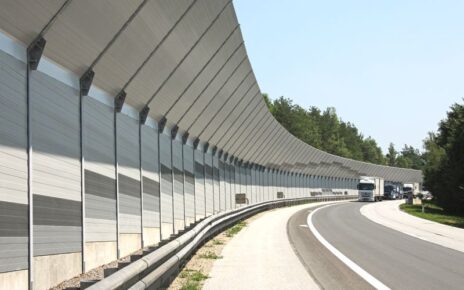You finally get home after a long day, ready to relax with a cup of tea and your favourite book. You take a deep breath, settle into your cosy spot, and then—HONK! A car alarm blares outside. A motorcycle roars down the street like it’s auditioning for a Fast & Furious sequel. Upstairs, your neighbour has apparently decided tonight is the perfect time to learn tap dancing.
Welcome to city living, where noise pollution is part of the package.
But what if the key to a quieter, more peaceful urban life isn’t abandoning your dream apartment or investing in top-tier noise-cancelling headphones? It’s sound barriers.
Noise Pollution: The Urban Menace We Don’t Talk About Enough
We’ve all heard about air pollution, but noise pollution? That’s the sneaky stressor we don’t always acknowledge. It doesn’t leave visible smog in the air, but its effects on our well-being are just as real.
Studies have linked long-term exposure to high noise levels with increased stress, anxiety, sleep disturbances, and even serious health risks like high blood pressure and heart disease. And it’s not just about the volume—it’s the consistency.
If your brain is constantly bombarded with noise, even at low levels, it never gets a chance to fully relax. No wonder so many urban dwellers struggle with sleep and concentration.
The worst part? You don’t need to live next to an airport or a nightclub to be affected. City life naturally comes with traffic, construction, sirens, and just the general buzz of people living loudly.
Enter Sound Barriers: The Ultimate Urban Shield
So, what exactly are sound barriers, and how do they work?
At their core, sound barriers are structures designed to block, absorb, or deflect sound waves before they reach your ears. They’re often seen along highways, train tracks, and busy streets, acting as invisible shields between noisy environments and quiet spaces.
But they’re not just massive concrete walls lining freeways. These days, sound barriers come in various shapes, materials, and even aesthetic forms—some doubling as public art installations or green walls filled with plants that absorb sound naturally.
How Sound Barriers Actually Work
Sound waves behave a bit like ripples in the water—when they hit an obstacle, they either bounce off, get absorbed or travel around it. Sound barriers work in three main ways:
- Absorption: Some materials (like dense foam, fibreglass, or perforated metal) absorb sound instead of letting it bounce around, reducing echo and noise levels.
- Reflection: Hard, solid surfaces (like concrete or thick glass) bounce sound waves back in the opposite direction, keeping noise from passing through.
- Diffusion: Some barriers scatter sound waves, breaking them up so that they lose their intensity before reaching the other side.
The best sound barriers combine all three methods, creating a powerful shield against urban noise.
Where Can Sound Barriers Make the Biggest Difference?
Noise pollution isn’t just annoying, it can disrupt sleep, reduce productivity, and even impact mental health. Here’s where sound barriers can work their magic:
1. Residential Areas
Living next to a busy road? Good luck trying to sleep with the constant hum of traffic outside. Tall acoustic fences, soundproof windows, and even thick landscaping can help create a buffer between your home and the outside world.
2. Offices & Workspaces
Ever tried focusing in an open-plan office? It’s nearly impossible to get deep work done between phone calls, keyboard clacking, and casual chit-chat. Sound barriers (like noise-absorbing partitions and ceiling panels) reduce distractions and increase productivity.
3. Public Parks & Outdoor Spaces
Cities are increasingly adding efficient sound barriers in public spaces to create peaceful pockets within noisy environments. Green walls filled with dense vegetation not only block noise but also improve air quality. It’s a win-win for urban design.
4. Highways and Railways
Highway sound walls aren’t just there for decoration. They significantly reduce traffic noise for nearby residents. Some cities are even experimenting with solar panel sound barriers, which absorb sound while generating renewable energy.
Beyond Physical Barriers: Other Ways to Reduce Urban Noise
While sound barriers are effective, they’re not the only solution to urban noise pollution. Here are a few complementary strategies cities (and individuals) can adopt:
1. Smarter Urban Planning
Cities can reduce noise pollution by designing quieter streets, restricting heavy traffic in residential zones, and incorporating more pedestrian-friendly areas. Some cities even use noise cameras to fine excessively loud vehicles.
2. More Green Spaces
Parks and trees do more than look nice—they naturally absorb sound and create pockets of tranquillity within noisy urban environments. More greenery equals a quieter city.
3. Noise-Reducing Building Materials
Modern architecture incorporates soundproof glass, insulated walls, and innovative materials that cut down noise inside buildings. Some cities even offer soundproofing grants for homes in high-noise areas.
4. Personal Soundproofing Hacks
If you’re dealing with noisy neighbours, heavy curtains, thick rugs, and even bookshelves filled with books can help absorb sound inside your home. For renters, removable acoustic panels are a game-changer.
Are Sound Barriers Enough to Create a Peaceful Urban Future?
So, do sound barriers hold the secret to a peaceful urban life? They’re definitely a huge piece of the puzzle, but they’re not the only solution.
Effective noise reduction requires a combination of smart city planning, innovative materials, and conscious design choices that prioritise quiet spaces. While we may never fully escape the sounds of city life, we can absolutely make them less overwhelming. Until then, investing in soundproofing tricks—whether at home, in the office, or through city infrastructure—might just be the best way to keep your sanity intact.
Final Thought: Should Cities Be Doing More?
The reality is, noise pollution isn’t going away anytime soon. With growing urban populations and ever-expanding infrastructure, cities will only get louder unless proactive measures are taken.
Sound barriers are a great start, but the real secret to a peaceful urban life lies in rethinking how we design cities, buildings, and public spaces. The ultimate goal? Not just to block noise, but to create environments that naturally promote quiet, relaxation, and well-being.
So, while sound barriers are valuable, they should be seen as one piece of the puzzle rather than a magic fix. A truly peaceful city isn’t just about silencing the noise, it’s about designing a world where we don’t need to fight it in the first place.





